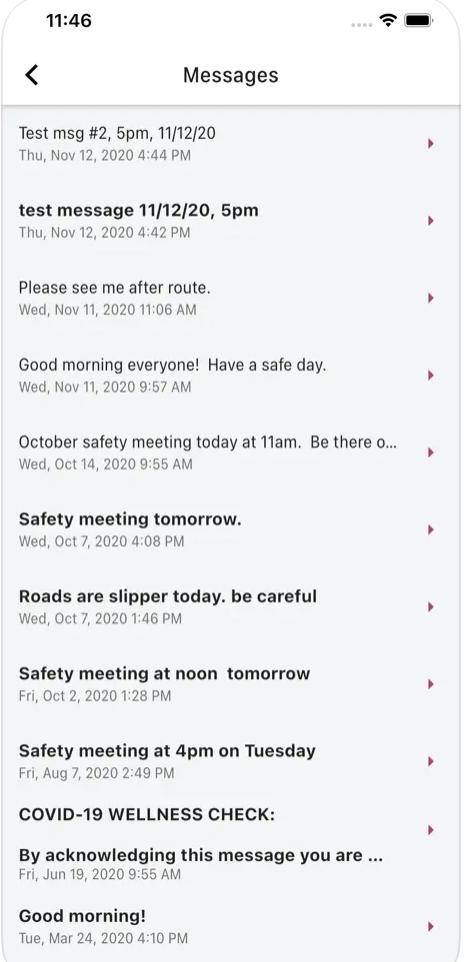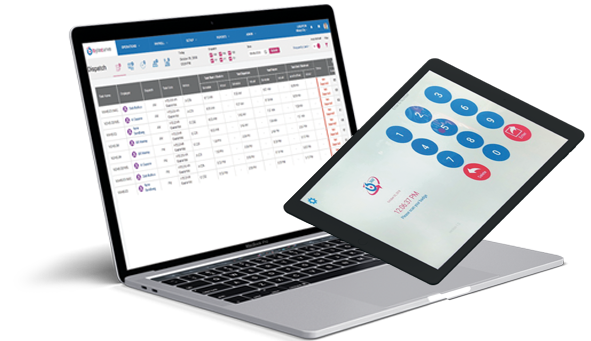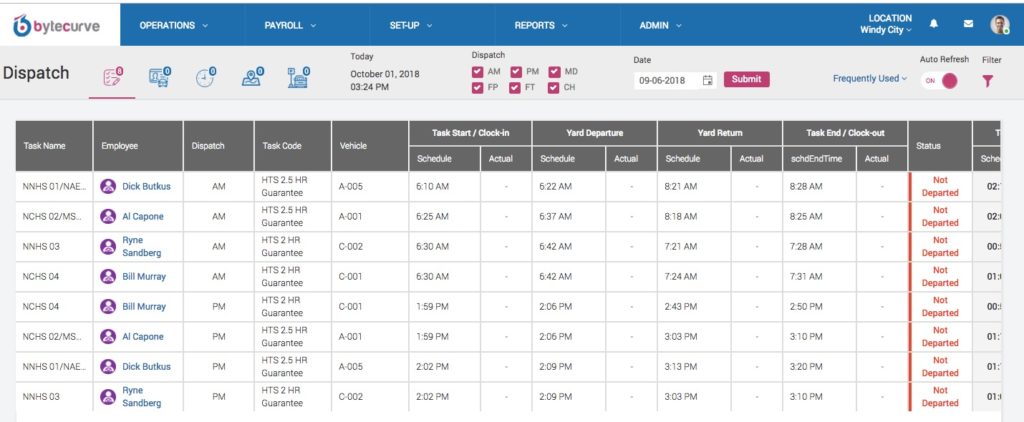2 + 2 = 5
Say goodbye to independent technology silos that don’t communicate or deliver an integrated experience.
And say hello to a comprehensive view of your operations, payroll and communications that transforms your daily operations.
Our School Bus Operating platform arms your team with the information they need to improve decision making around safety, reducing costs, and being more efficient each day.
Trusted by dozens of public and private student transportation fleets to improve how they do business.


ByteCurve360 enables transportation organizations to improve safety and operational efficiency by merging routing and GPS fleet tracking data into a comprehensive management tool.
Task drivers, reassign routes and verify payroll in seconds.
Better manage late/absent drivers and deliver on-time performance your students depend on.
Trusted by the Finest Names in School Bus Transportation
Revolutionizing Fleet Management: Unraveling the Power of GPS Dispatching Systems
Many, if not most, larger school districts and private school bus fleets rely on GPS Fleet Tracking today, as well as routing software, to enhance their operations and improve student safety. These technologies are now as standard as a recruitment plan for mechanics and drivers and integrated safety training.
Yet most districts remain unaware of a new emerging technology designed to connect the two previously independent platforms into a 360-degree view of operations to empower dispatchers, payroll technicians and fleet directors to realize even greater operational efficiencies and opportunities to increase safety.

Bytecurve360, developed and supported by a team with more than 100 years of combined student transportation experience, is growing in popularity among fleets who leverage both routing and GPS Fleet tracking.
Featuring a driver communication app, a payroll tool that can be leveraged in the garage via desktop or on the go via the driver app as well as dispatch features designed by a team with years of experience managing complex and dynamic school bus fleets, Bytecurve360 delivers a transformative operational experience.
Some of the most essential features include:
- Better Driver communications so that employees can check in/out remotely, view their schedules and receive messages on their smartphones.
- Easier payroll management so that you no longer have to manually calculate employee guarantees/contracts and overtime.
- Simpler management of daily operations, including assigning/reassigning drivers and vehicles, using real-time integration with GPS and routing systems. This allows all stops to be easily be rerouted when a bus breaks down or a driver can’t come in.
“It’s helped us provide a new level of command and control that allows us to be ahead of issues instead of responding to them,”
Marty Klukas, General Manager, Student Transit.
Revolutionizing Fleet Management: Unraveling the Power of GPS Dispatching Systems
Many, if not most, larger school districts and private school bus fleets rely on GPS Fleet Tracking today, as well as routing software, to enhance their operations and improve student safety. These technologies are now as standard as a recruitment plan for mechanics and drivers and integrated safety training.
Yet most districts remain unaware of a new emerging technology designed to connect the two previously independent platforms into a 360-degree view of operations to empower dispatchers, payroll technicians and fleet directors to realize even greater operational efficiencies and opportunities to increase safety.
Bytecurve360, developed and supported by a team with more than 100 years of combined student transportation experience, is growing in popularity among fleets who leverage both routing and GPS Fleet tracking thanks to its ability to
- Improve driver management
- Better control costs associated with payroll
- Deliver improved services to schools and families
Not designed to replace either system, Bytecurve360 aims to connect dots that were previously constrained by technology silos into a more comprehensive perspective of student transportation management.
Featuring a driver communication app, a payroll tool that can be leveraged in the garage via desktop or on the go via the driver app as well as dispatch features designed by a team with years of experience managing complex and dynamic school bus fleets, Bytecurve360 delivers a transformative operational experience.
“It’s helped us provide a new level of command and control that allows us to be ahead of issues instead of responding to them,” said Marty Klukas, General Manager, Student Transit. “It let us know what right looks like and build our plans around doing it right.”
GPS Dispatching for Buses: Student Transportation Safety
A GPS (Global Positioning System) dispatching system combines the capabilities of GPS technology with software that allows for the real-time tracking and management of vehicles. These systems are particularly useful for fleets, as they provide precise data about
- Each vehicle’s location
- Speed
- Route history
- Idle times and more
First of all, with real-time tracking, transportation departments can immediately locate any bus in their fleet. This can be especially important in emergencies and when communicating with parents or guardians in real time.
Also, knowing that the buses are monitored, drivers are more likely to adhere to speed limits and other traffic regulations.
The dispatching software can also analyze traffic patterns, road conditions, and other factors to suggest the most efficient routes. This can help in saving fuel and time and also in making sure that students are picked up and dropped off on time. When on-time arrival is the first step toward a successful school day, having this location data to drive better operations is now considered essential for most school districts.
With real-time tracking and historical data, school districts can also more accurately predict bus arrival times. This can be particularly useful for parents and students waiting for the bus.
Some advanced systems can also track the health of the bus, notifying the transportation department of any maintenance needs before they become critical. Some even can link mechanical issues to a work-order software solution so mechanics in the garage are alerted to issues before the bus even returns to the yard, further improving operations.
Efficient routes also mean less fuel consumption and wear and tear on the buses, leading to cost savings in the long run.
If there’s a delay or any other unexpected incident, the central dispatch can also communicate directly with the bus driver, ensuring a quicker response to any situation.
Moreover , by monitoring driving behaviors, such as speeding or harsh braking, transportation departments can ensure that drivers are following best practices and can provide training or interventions if necessary.
In the event of disputes or complaints about missed stops or bus timings, the GPS data can also be reviewed to verify events.
Some systems can also monitor how long a bus is idling, which can help reduce unnecessary fuel consumption and emissions. Many districts and urban areas have adopted “No Idling” zones for commercial vehicles as well as school buses because the emissions are linked to poor air quality and decreased quality of life for citizens.
Lastly, by optimizing routes and reducing idle times, fuel consumption can be minimized, leading to a reduced carbon footprint. While there is a major trend afoot to convert to electric buses, bolstered by a raft of federal and state grants designed especially for school buses, this process will take years if not decades and will mean many more years of opportunities for fuel savings with a GPS system.
GPS dispatching systems provide school districts with a host of advantages that not only make the operation of buses more efficient but also enhance the safety and reliability of the service. As technology continues to evolve, it’s likely that these systems will incorporate even more features to aid in the management of school transportation.
What are the key components of GPS dispatching systems?
A GPS dispatching system is a complex integration of hardware, software, and communication networks.
- GPS receiver
- This is the most basic component, often installed in each vehicle.
- It receives signals from satellites to determine the vehicle’s precise location, speed, direction, and time.
- Uses triangulation from multiple satellites to determine accurate position.
On-board diagnostics (OBD) interface - Often integrated with the GPS receiver or may exist as a separate unit.
- Gather data about the vehicle’s health, fuel consumption, idling times, and more.
- It can leverage technologies like CAN (Controller Area Network) bus systems in vehicles to collect diagnostic data.
Mobile data terminal (MDT) or In-cab display - Allows for two-way communication between the driver and the dispatcher.
- Displays information like optimal routes, real-time traffic updates, and messages from the dispatcher.
- Can utilize touchscreen technology and user-friendly GUIs (Graphic User Interface) for ease of use.
Communication modems & network - Provides the link between the in-vehicle GPS device and the central dispatching software.
- Uses cellular (e.g., 4G/5G), satellite, or radio frequencies to transmit data in real-time.
- Embedded SIM cards or eSIM technologies can be part of this setup.
Central dispatching software - Resides at the base station or can be cloud-based.
- Provides real-time tracking of all vehicles, route optimization, scheduling, reporting, and analytics.
- May use Machine Learning and AI for predictive maintenance, traffic prediction, and route optimization.
- Integrates with databases and other enterprise systems for comprehensive fleet management.
User interface (web & mobile apps) - Allows dispatchers, fleet managers, and sometimes end-users (like parents in the context of school buses) to track vehicles, communicate with drivers, and access various reports.
- Leverages web technologies and mobile app development frameworks.
Cloud infrastructure - Many modern GPS dispatching systems use cloud platforms for scalability, data storage, and analytics.
- Leveraging services like AWS, Azure, or Google Cloud ensures high availability, redundancy, and security of data.
Database systems - Store vast amounts of data like vehicle locations, routes taken, fuel consumption, maintenance records, and more.
- Uses relational databases, NoSQL databases, or time-series databases depending on the system’s requirements.
Integration APIs - Allows the GPS dispatching system to communicate with other enterprise systems or third-party applications.
- RESTful APIs, SOAP, and other web services technologies can be part of this.
- Bytecurve360 leverages this technology to ingest data from both the Routing and GPS Fleet Tracking system to deliver an actionable dashboard that allows for real-time dispatching
Notifications and alerts system - Sends out real-time alerts to dispatchers or drivers in case of deviations, emergencies, or other predefined events.
- Utilizes SMS, push notifications, or email technologies.
- Bytecurve360 leverages this technology
GPS dispatching systems leverage a multitude of technologies ranging from satellite communication to machine learning.
The integration of these technologies ensures that the system is efficient, reliable, and responsive to the dynamic needs of fleet management. And when combined with a dispatching tool like Bytecurve360, a GPS Fleet Tracking solution designed for bus transit or bus customers can deliver significant value, sometimes paying for itself in fuel savings alone.
How do GPS dispatching systems compare with alternative solutions?
GPS dispatching systems have revolutionized the way fleets operate and manage their resources, offering a host of advantages over traditional manual dispatching methods.
In the first place, GPS dispatching enables real-time tracking of vehicles, allowing for immediate rerouting based on live traffic data, road closures, or other unforeseen circumstances.
In manual dispatching, on its part, rerouting usually relies on drivers’ knowledge or requires communication over radios or phones, leading to delays and potential miscommunications.
GPS dispatching also provides constant monitoring of vehicle locations and speeds, ensuring adherence to safety standards.
The technology also offers geofencing features that alert when a vehicle travels outside a designated area. Alternatively, without real-time monitoring, it’s challenging to know if drivers are following safety guidelines until an incident occurs.
GPS dispatching also provides precise data on vehicle locations, speeds, routes taken, and estimated arrival times. While manual dispatching relies heavily on driver feedback, which can sometimes be inaccurate or delayed.
Cost
When implementing GPS dispatching, initial setup and subscription costs are associated, but in the long run, these systems can lead to significant savings due to
- optimized routes
- reduced fuel consumption
- and better vehicle maintenance.
Manual dispatching may have lower initial costs, but can be more expensive in the long run due to inefficiencies, potential for human error, and lack of data-driven decisions.
GPS dispatching facilitates instant two-way communication between drivers and dispatchers.
Dispatchers can send messages directly to a driver’s in-cab display. On the other hand, manual dispatching relies on phones or radio systems which can be less reliable, especially in areas with poor reception.
GPS dispatching collects a vast amount of data for analysis.
Fleet managers can access reports on
- fuel consumption
- driver behavior
- maintenance needs
- and more
In manual dispatching data collection is labor-intensive and often incomplete, making it difficult to generate comprehensive reports.
GPS dispatching can predict maintenance needs based on vehicle diagnostics, reducing downtime and ensuring the longevity of the fleet. Alternatively, with manual dispatching: Requires drivers or maintenance personnel to manually check and report on vehicle health.
GPS dispatching systems are also scalable and can handle fleets of any size. Adapting to changes or expansions is relatively seamless.
As fleets grow and routes become more dynamic, manual methods become more cumbersome and less effective.
GPS Dispatching
Requires training for both dispatchers and drivers on how to use the system. In manual dispatching, while the system might be simpler, training on best practices and efficient communication is still necessary.
By optimizing routes, reducing idle times, and ensuring timely maintenance, GPS dispatching systems can also contribute to reduced fuel consumption and emissions.
On the other hand, manual dispatching is less efficient in terms of route optimization, potentially leading to higher fuel consumption.
While manual dispatching might still work for very small operations or in areas where technology adoption is limited, GPS dispatching systems provide a far more advanced, efficient, and data-driven approach to fleet management.
The benefits in safety, cost savings, and operational efficiency make GPS-based systems the preferred choice for most modern fleet operations.

What are the major pain points for school districts GPS dispatching systems resolve?
GPS dispatching systems address several challenges faced by fleet managers and operators.
To begin with, without real-time data, traditional route planning can lead to longer travel times, increased fuel consumption, and unnecessary wear and tear on vehicles.
GPS systems provide dynamic route optimization based on real-time traffic data, road conditions, and other variables, ensuring that vehicles take the most efficient routes.
Also, fleet managers without GPS technology often don’t know the exact location of their vehicles or the status of deliveries or services. Real-time tracking allows fleet managers to know exactly where each vehicle is, improving response times, customer service, and overall operational efficiency.
Without monitoring, there’s also limited visibility into unsafe driving behaviors, like speeding or harsh braking. GPS systems can monitor driving patterns and provide alerts for unsafe behaviors, enhancing overall fleet safety.
Unexpected vehicle breakdowns can also result in service disruptions, missed appointments, and increased costs. Advanced GPS dispatching systems can integrate with vehicle diagnostics to predict maintenance needs, reducing unexpected downtimes.
Manual logging and reporting can be labor-intensive, error-prone, and may not capture all necessary data.
Automated data collection and reporting features offer insights into various operational metrics, simplifying decision-making.
Without proper oversight, vehicles might also take longer routes or idle unnecessarily, leading to increased fuel consumption. Route optimization and idling reports help in reducing fuel wastage and costs.
Customers may also complain about late deliveries or service appointments when there’s no real-time tracking. Real-time vehicle tracking can offer more accurate ETAs and improve communication with customers.
Theft or unauthorized use of vehicles can be a significant concern too.
Geofencing features can alert managers if a vehicle moves outside a predefined area, enhancing security.
Without proper oversight, there’s also potential for unproductive labor, e.g., drivers taking longer breaks.
Real-time monitoring ensures that vehicles are on the move as needed, optimizing labor efficiency.
By addressing these challenges, GPS dispatching systems provide a more streamlined, efficient, and accountable fleet operation. They empower managers with data-driven insights, ensuring optimal utilization of resources and enhanced customer satisfaction.
Driving into the Future: Why Your Fleet Deserves the Byte Curve Advantage
In an era where technology is driving change at unprecedented speeds, fleet management can’t afford to remain in the rearview mirror.
GPS dispatching systems are not just a modern upgrade; they are a transformative tool that addresses critical pain points, enhances safety, optimizes resources, and delivers undeniable ROI.
These systems weave together real-time data, analytics, and actionable insights to craft a roadmap for more efficient and effective fleet operations.
If you’ve ever found yourself lost amidst the challenges of manual dispatching or yearned for a clearer view of your fleet’s movements and health, the answer is clear. It’s time to steer your operations into the future.
Ready to navigate the fast lane to enhanced fleet management? Consider investing in the Byte Curve GPS dispatching system – where precision meets performance.
And when combined with the Bytecurve360 dashboard, which also integrates data from all the major routing providers, student transportation leaders can transform the way they manage school bus fleets to improve safety, efficiency and payroll.
Integrated Student Transportation Software

Secure
Only authorized employees will be able to access DriveOn based on a customer specific access code. This code can be turned off as needed by an authorized administrator.

User friendly
DriveOn is easy to use with a simple, smart interface.
Available on both iOS and Google Play stores.





